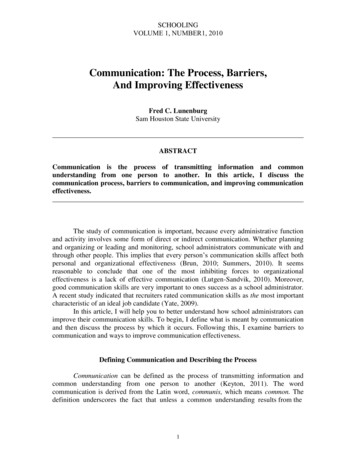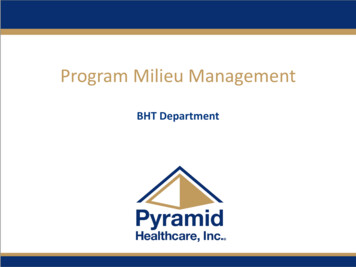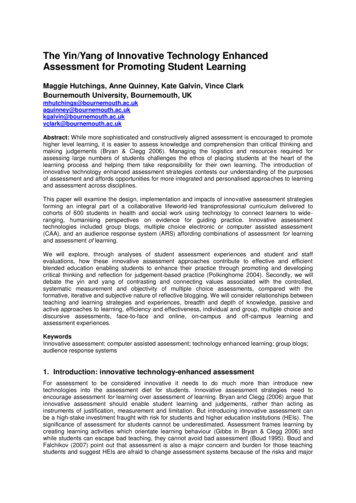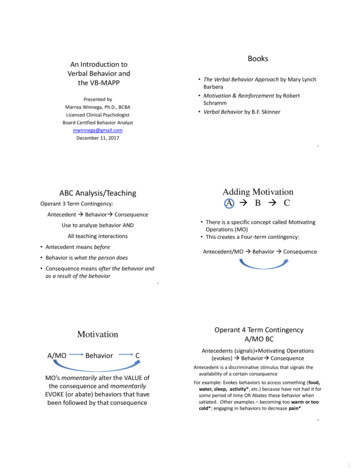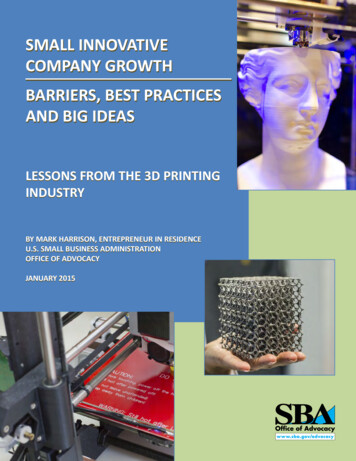
Transcription
SMALL INNOVATIVECOMPANY GROWTHBARRIERS, BEST PRACTICESAND BIG IDEASLESSONS FROM THE 3D PRINTINGINDUSTRYBY MARK HARRISON, ENTREPRENEUR IN RESIDENCEU.S. SMALL BUSINESS ADMINISTRATIONOFFICE OF ADVOCACYJANUARY 2015
SMALL INNOVATIVE COMPANYGROWTH: BARRIERS, BEST PRACTICESAND BIG IDEASLESSONS FROM THE 3D PRINTING INDUSTRYBY MARK HARRISON, ENTREPRENEUR IN RESIDENCEU.S. SMALL BUSINESS ADMINISTRATIONOFFICE OF ADVOCACYRELEASE DATE: JANUARY 2015
THE OFFICE OF ADVOCACYCreated by Congress in 1976, the Office of Advocacy of the U.S. Small Business Administration (SBA) is anindependent voice for small business within the federal government. Appointed by the President andconfirmed by the U.S. Senate, the Chief Counsel for Advocacy directs the office. The Chief Counsel advancesthe views, concerns, and interests of small business before Congress, the White House, federal agencies,federal courts, and state policy makers. Economic research, policy analyses, and small business outreach helpidentify issues of concern. Regional Advocates and an office in Washington, DC, support the Chief Counsel’sefforts.The full text of this report is available on the Office of Advocacy’s website at www.sba.gov/advocacy.Information about Advocacy’s initiatives on behalf of small businesses is widely accessible: Via three Listservs(regulatory communications, news, and research) and social media including a blog, Twitter feed, andFacebook page. All of these are accessible from the Advocacy website, www.sba.gov/advocacy.We welcome your support of Advocacy’s efforts on behalf of America’s dynamic small business sector.Small Innovative Company Growth2Barriers, Best Practices and Big Ideas
TABLE OF CONTENTSForeword . 4Introduction. 6The Office of Advocacy’s Innovation Initiative . 6PART ONE: An Innovation Case Study . 8Innovation. 8Who are the innovators?. 8Innovation and manufacturing in the United States . 9Additive Manufacturing. 10The Additive Manufacturing Industry . 11Personal 3D printers—The Maker Community . 12Benefits of Additive Manufacturing . 12Challenges for Additive Manufacturing. 13Moving Forward . 14The Innovation Process . 15The role of the federal government in innovation . 17PART TWO: Barriers, Best Practices, and Big Ideas . 19Barrier 1: The amount of student debt held by graduating students prevents them frompursuing entrepreneurial opportunities. 21Barrier 2: The amount of funding and support of research and development in the UnitedStates needs to increase. . 22Barrier 3: Entrepreneurs often lack information regarding market needs and productresearch and development efforts. . 26Barrier 4: There is a shortage of engineering and production job talent. . 28Barrier 5: Access to capital still impedes small business growth. . 32Barrier 6: Small innovative companies have difficulty commercializing products . 36Barrier 7: Technology diffusion and adoption is more difficult for small businesses. . 38Barrier 8: High equipment costs are a barrier to entry for small businesses implementingnew technologies. 41Barrier 9: Small companies need access to more business opportunities. . 42Barrier 10: Technology innovations often result in regulatory uncertainty and legalchallenges. . 44Barrier 11: Small companies continue to face challenges exporting their products andservices. . 47CONCLUSIONS . 51Other Reading. 53Small Innovative Company Growth3Barriers, Best Practices and Big Ideas
FOREWORDInnovation in the United States has been one of the driving forces in our development as one of theleading economies in the world. Innovations commercialized by U.S. companies have also benefitedour society by allowing us to attain prosperity and a good quality of life. While large corporationsand the federal government play important roles in the development of innovative products andservices, the story is incomplete without the significant contributions and role of individualentrepreneurs and small, agile, high-growth businesses in developing innovative products in thefields of science, technology and engineering. Small companies comprise the overwhelming majorityof all businesses in the United States and they must be able to effectively and efficiently bring theirinnovative products and services to market and grow. Therefore, as the United States moves intothe future, we need policies and programs to support the development of an innovation ecosystemthat allows small innovative firms to grow, thrive, and create jobs—building the economy and astronger America.Implementing effective policies is more critical now than ever if the United States is to remain aleader in today’s highly interconnected and hypercompetitive global economy. Both developed anddeveloping countries have and are continuing to implement policies and programs to foster theirown innovation ecosystems and economies. 1 However, innovation is not an easy or straightforwardtask despite the many resources dedicated to it. Small businesses trying to bring innovativetechnology products and services to market often face unique challenges and barriers not faced bylarge multinational corporations, and they must often overcome such barriers with fewer resources.The Office of Advocacy's Innovation Initiative focuses on the needs and concerns of smallinnovative companies. The Innovation Initiative was designed to investigate the challengesindividual entrepreneurs and small high-growth companies face in attempting to commercialize aninnovative product or service. This report describes eleven key barriers to small innovativecompany growth. Each barrier is discussed in three parts: What We Heard—Describing the input from entrepreneurs, private industry and otherparticipants in the innovation ecosystem as a result of Advocacy’s outreach efforts;Best Practices—Identifying best practices or recent activities around an identifiedbarrier; andBig Ideas and Recommendations—Highlighting policies or programs that should beconsidered by the federal government to overcome such barriers.Developing and exchanging new ideas on innovation is essential to the United States’ ability tocompete and to lead in the 21st century global economy. As President Obama stated in his 2014State of the Union address:“We know that the nation that goes all-in on innovation today will own the global economytomorrow. This is an edge America cannot surrender.”1National Research Council, Rising to the Challenge: U.S. Innovation Policy for the Global Economy (Washington D.C.: TheNational Academies Press 2012) 201-319.Small Innovative Company Growth4Barriers, Best Practices and Big Ideas
This report is one piece of this effort. We would like to acknowledge and thank the many individualswho shared their expertise and perspective on the subjects studied here. Special thanks go to theInstitute of Electrical and Electronics Engineers for sharing information on the results of itsmembership survey on challenges to technology company growth.Winslow Sargeant, Ph.D.Chief Counsel for AdvocacyMark HarrisonEntrepreneur in ResidenceOffice of AdvocacyJanuary 2015Small Innovative Company Growth5Barriers, Best Practices and Big Ideas
INTRODUCTIONThe Office of Advocacy’s Innovation InitiativeThe Office of Advocacy launched the Innovation Initiative in 2013. The goal of this initiative is toidentify the challenges and barriers hindering the growth and development of small innovativecompanies and offer solutions to surmount such barriers. The Office of Advocacy’s InnovationInitiative is comprised of the following components: Outreach to innovation and entrepreneurial small business stakeholders,Communicating the feedback and concerns to appropriate federal agencies, andReporting the initiative’s findings.Dr. Winslow Sargeant, chief counsel for advocacy, has led a coordinated outreach effort amongst histeam, including 10 regional advocates, an Office of Interagency Affairs, an Office of EconomicResearch and, most recently, an entrepreneur-in-residence. Advocacy has sponsored a series ofsymposiums titled “Small Business and Government: Maximizing Entrepreneurship, DrivingInnovation” aimed at bringing together individuals working in the innovation ecosystem to hearfirsthand about the challenges to growing successful businesses. (See sidebar.)Advocacy’s outreach efforts over the past two years provided information and insight into emerginginnovation sectors such as green technology, renewable/alternative energy, advancedmanufacturing; much of this input falls into one of three categories, which Advocacy terms “the 3Bs”: Barriers, Best Practices and Big Ideas. While Advocacy received feedback on many barriers andindustry sectors, most of the concerns centered on the development of new technology by smallbusinesses and advanced manufacturing. In FY 2013, Advocacy continued outreach efforts to theinnovation ecosystem looked more closely at issues regarding new technology/productdevelopment and advanced manufacturing.Advocacy focused on one particular innovation/technology industry in order to determine ifbarriers, best practices, and big ideas found in that industry are instructive for technology industriesgenerally. The technology industry chosen was additive manufacturing (also referred to as 3Dprinting). The additive manufacturing industry met the criteria for further evaluation in that it is asubset of advanced manufacturing and is experiencing a fast pace of innovation.Small Innovative Company Growth6Barriers, Best Practices and Big Ideas
INNOVATION ANDENTREPRENEURSHIPSYMPOSIUMSIn 2012, the Office of Advocacylaunched a series of symposiumscalled “Small Business andGovernment: MaximizingEntrepreneurship, DrivingInnovation.” These events allowAdvocacy staff to hear firsthandabout the challenges to growingsuccessful businesses. Symposiumshave been held in three cities:Seattle, WashingtonSeptember 2012Pittsburgh, PennsylvaniaMarch 2013New Orleans, LouisianaMay 2014In addition, Chief Counsel Sargeantand many members of Advocacy’sstaff have taken part in roundtablesand meetings on challenges toinnovative company growth. Threeof these took place in September2013 in Wilmington, Delaware;Philadelphia, Pennsylvania; andCamden, New Jersey. Future eventsare in the planning stages.The review of data and information on the additivemanufacturing industry has been highly qualitative relying onthe review of secondary source materials (e.g., researchreports, white papers, articles, etc.) from organizations suchas McKinsey, Gartner, PriceWaterhouseCoopers, Ernst &Young, universities, research laboratories, trade and businessorganizations, and the popular and trade press. Advocacy’sentrepreneur-in-residence and regional advocates were indirect contact with more than 80 individuals in the additivemanufacturing industry and the innovation ecosystem,including entrepreneurs, researchers, government officials,venture capitalists, and angel investors. Advocacy was alsogiven access to data collected by the Institute of Electricaland Electronics Engineers, or IEEE, from its members via anonline survey conducted in July 2014 on issues surroundingchallenges to growth for technology companies. 2 Thiscollective outreach was crucial to understanding the issuesfacing small businesses in the additive manufacturingindustry and is one of Advocacy’s core missions and strengths—providing insights from U.S. small businesses topolicymakers on the issues that directly affect them.Part One of this report focuses on various aspects ofinnovation as well as the additive manufacturing industry,which provides a framework for analyzing barriers to smallinnovative company growth. Part Two discusses the 11barriers to small innovative company growth. For each, itpresents relevant best practices or recent activities, as well asprogram and policy ideas and recommendations forconsideration by the federal government.2IEEE is a professional association of persons working in technology fields whose mission is to foster technologicalinnovation and excellence for the benefit of humanity. The IEEE survey had 240 respondents; 90% owned their ownbusiness, 99% had less than 99 employees, and 20% were owned by a minority, woman, or veteran.Small Innovative Company Growth7Barriers, Best Practices and Big Ideas
PART ONE:AN INNOVATION CASE STUDYINNOVATIONThe federal government sees innovation as the key to future U.S. growth and internationalcompetitiveness. 3 According to a PriceWaterhouseCoopers survey, 80% of the participatingexecutives identified growth as a top priority over the next five years and 93% believe that organicgrowth through innovation will be the primary driver of revenue growth. 4 An innovation is theimplementation of a new or significantly improved product(good or service), or process, a new marketing method, or anew organizational method in business practices, workplaceorganization or external relations. 5 It is important to note thatHOW MANY SMALL HIGHfor new products and services to be considered innovations,TECH FIRMS ARE THERE?they must be commercialized—introduced into the market. 6While there are numerous theories about the number ofWhile small businesses make updifferent types of innovation, we focused on small companiesapproximately 99.7% of the 28.2working on breakthrough or radical innovations 7 since thesemillion businesses in the Unitedtypes of innovations present the highest potential to create jobsStates, only 5.7 million of theseand new markets, and have substantial impact on thesmall businesses actually haveeconomy. 8employees. Based on internalWho are the Innovators?While the federal government and large corporations play asignificant role in innovation in the United States, smallbusinesses make unique and indispensable contributions aswell. Media coverage of small high-tech companies developingnew products suggests that there are a large number of suchfirms in the United States; however the Office of Advocacyestimates that around 250,000–350,000 small businesses areinvolved in high technology sectors. 9 Although relatively small innumber, these small technology companies have demonstratedcalculations of Census data donefor this report analyzing thenumber of firms in certain hightechnology industry NAICS codes,the Office of Advocacy estimatesthe number of small businessesin high technology sectors to bebetween 250,000 and 350,000.3The White House, A Strategy for American Innovation–Securing Our Economic Growth and Prosperity, February 2011.PriceWaterhouseCoopers, Breakthrough Innovation and Growth, September 2013.5OECD, 2005, The Measurement of Scientific and Technological Activities: Guidelines for Collecting and InterpretingInnovation Data: Oslo Manual, Third Edition, prepared by the Working Party of National Experts on Scientific andTechnology Indicators, OECD, Paris, para. 146, accessed December 22, 2014.6Robert Litan, Andrew W. Wyckoff, and Kaye Husbands Fealing, eds. Capturing Change in Science, Technology andInnovation: Improving Indicators to Inform Policy, (Washington, D.C., The National Academies Press) 2013.7Jake Neilson, Four types of innovation and the strategic choices each one represents, Innovation Excellence blog, January12, 2014.8Clayton Christensen, We are living the capitalist’s dilemma, CNN Website, January 21, 2013. Accessed August 20, 2014.9U.S. Small Business Administration, Office of Advocacy, Frequently Asked Questions, March 2014. Office of Advocacyestimate.4Small Innovative Company Growth8Barriers, Best Practices and Big Ideas
WHAT IS AN INNOVATION?There are many definitions of“innovation,” however the commonthread is the commercialization ofsomething new.What distinguishes an innovation froman invention? Commercialization—orbringing a product or service tomarket.Breakthrough innovations are new,bold and substantially superior to thenext best available thing. This is whatmost people have in mind whenthinking about innovation.Radical innovations create drasticchanges to the competitiveenvironment for a product or service,or creates new businesses.Sources: “The Measurement ofScientific and Technological Activities:Guidelines for Collecting andInterpreting Innovation Data: OsloManual, Third Edition,” OECD, Paris.Capturing Change in Science,Technology and Innovation: ImprovingIndicators to Inform Policy, RobertLitan, Andrew W. Wyckoff, and KayeHusbands Fealing, eds. “Four Types ofInnovation and the Strategic ChoicesEach One Represents,” Jake Neilson.Breakthrough Innovation and Growth,PriceWaterhouseCoopers.the ability for significant job creation. 10 However, for thesecompanies to create these jobs and other economicdevelopment benefits, they must be growing businessesand not just startups. Thus in order for the United States toobtain the maximum economic and societal benefits frominnovation, policies must be in place that allow these smallcompanies to start their firms, innovate, bring newproducts and services to market, and grow their businesses.Innovation and Manufacturing in the United StatesAs stated in the White House report, Making in America:U.S. Manufacturing Entrepreneurship and Innovation, theU.S. manufacturing sector is growing and is pivotal to theinnovation economy. 11 The report states that themanufacturing sector employs 60% of private sector R&Demployees in the U.S. and contributes 75% of private sectorresearch and development. Manufacturing firmsintroduced a new product or service and new production ordistribution method at twice the rate of non-manufacturingfirms, and most high-technology manufacturing sectorsinnovate at twice the rate of all manufacturing firms. 12Recent manufacturing innovations are providing anadvantage to U.S. manufacturing firms by loweringproduction costs and reducing the time to get products tomarket. This has led to new manufacturing startups,increased investment in research and development, andincreases in manufacturing employment and within relatedsupply chains. 13One important manufacturing innovation creatingadvantages for U.S. manufacturers is additivemanufacturing. As part of Advocacy’s process of identifyingbarriers to small innovative company growth, outreachefforts have been focused on companies in the additivemanufacturing industry. Reviewing barriers of companies inall technology industries can lead to overly broadconclusions given the differences in characteristics amongemerging technologies. Choosing a specific industry enablesa better understanding of the challenges small companiesface in that industry which are likely to be applicable to thechallenges in other technology industries as well.10Hathaway, Ian, Tech Starts–High Technology Business Formation and Job Creation in the United States, The KauffmanFoundation, August 2013.11The Executive Office of the President, Making in America: U.S. Manufacturing, Entrepreneurship and Innovation, June2014.12National Science Foundation Business R&D and Innovation Survey (BRDIS) 2008.13The Executive Office of the President, Making in America.Small Innovative Company Growth9Barriers, Best Practices and Big Ideas
The choice of additive manufacturing was driven by three factors: The technology is potentially a breakthrough or disruptive one with a significant opportunityfor economic impact;The industry or technology is showing rapid advancement; andThere exists or potentially could be significant small business participation.The McKinsey Global Institute estimates that the economic impact of 3D printing could range from 230 billion to 550 billion by 2025 and noted that the rapidly improving technology is leading to anincrease in its use. 14 Additive manufacturing is being used and has the potential to significantlyaffect many industries. Small businesses are participating in many areas of the industry (3D printermanufacturers, materials, print shops, etc.). In addition, the President has demonstrated strongsupport of advanced manufacturing in the United States including additive manufacturing. AmericaMakes was founded in 2012 as a national accelerator for additive manufacturing and 3D printing. Itwas formerly called the National Additive Manufacturing Innovation Institute and is the pilotinstitute in President Obama’s initiative to build a national network for manufacturing innovation.(America Makes is discussed later in Part Two of this report, in connection with barrier no. 2, R&DSupport).ADDITIVE MANUFACTURINGAdditive manufacturing (AM) is increasingly being adopted in manufacturing and garneringsignificant attention in the media. 15 AM is defined as the process of joining materials to makeobjects from 3D models, usually layer upon layer, as opposed to subtractive methods. 16 While thetechnology has been around for almost 30 years, improvements in AM technologies are headingtowards an inflection point. AM is currently used across diverse industries including those producingconsumer, industrial, medical, automotive and aerospace products.The AM process begins with a digital 3D model generated using computer aided design (CAD)software. The CAD file is then converted to an STL file which instructs the 3D printer to create or“print” the object applying material layer by layer. AM was first and is still primarily used forprototyping and modeling. As the quality of the technology and materials improved AM has beenused to create tooling and finished parts. AM’s largest potential is its increased use to producefinished parts/products. 17AM is a significant innovative technology development. Even if AM is viewed only as a technologyfor rapid prototyping, modeling and tooling, it is significantly affecting manufacturing by reducingthe time and cost in the manufacturing process. However, as AM technical capabilities improve andit is increasingly used in the production of finished parts, the impact of AM will be even greater14McKinsey Global Institute, Disruptive Technologies: Advances That Will Transform Life, Business, and the GlobalEconomy, May 2013. Others have estimated the additive manufacturing market to reach between 21 billion and 200billion. Wohlers Associates, The Wohlers Report 2014.15Wohlers Associates, The Wohlers Report 2014. This report is the source of most of the background and statistics on theadditive manufacturing process and industry in this section.16As defined by the ASTM International Committee F-42 on Additive Manufacturing, a standards developmentorganization.17According to the Wohlers Report 2014, 29% of survey respondents are using additive manufacturing for finished orfunctional parts; 37% for prototyping/modeling ; 5.6% for tooling components; and 6% for education/research.Small Innovative Company Growth10Barriers, Best Practices and Big Ideas
affecting product quality and functionality, business models, supply chains, manufacturingfootprints, product logistics, etc.The Additive Manufacturing IndustryThe AM industry is growing. According to the Wohlers Report 2014, the compound annual growthrate for global revenues for all additive products and services during the last 25 years is 27%. In2013, global revenues from all products and services were 3.07 billion which were almost evenlysplit between product revenue ( 1.55 billion) and service revenue ( 1.52 billion). There are wideranging estimates of the size of the industry by 2020 from 21 billion to 230 billion; however today,AM is 0.03% of the 10.5 trillion global manufacturing market.The market is global, with AM systems being produced and used in many countries located in Africa(South Africa, Egypt), Asia (China, India, and Japan), Europe (Germany, France, UK, and Russia), aswell as in Brazil and Canada. However, the United States is the leader with 38% of installed industrialadditive systems worldwide with Japan, Germanyand China representing 9.5%, 9.1% and 8.8%respectively. Israel is the leader in production andsales of industrial additive systems with 54.7% of theADDITIVE MANUFACTURING ORmarket, followed by Europe at 21% and the United3D PRINTING?States at 18.6%. 18While the term “3D printing” hasThe AM service industry is also growing. The typicalbecome synonymous with additiveAM service provider may specialize in one or two AMmanufacturing, 3D printing is one ofprocesses (each process requires a differentseven different processes for additivemachine) and can provide a range of services frommanufacturing recognized by theproduction of prototypes to final parts. Two trends inASTM International Committee F-42the service industry are system manufacturerson Additive Manufacturing.beginning to offer production services and an active19M&A market for service providers. In addition,Source: The ASTM Internationalthere are new business models being createdTechnical Committee F42 on Additiveinvolving service providers and individual consumers.Manufacturing Fact Sheet.The development of 3D print shops where individualscan have an object 3D printed as a service is anopportunity for small businesses and is being pilotedby large companies such as Office Depot, Staples andUPS. Another model is bringing together 3D designers, parts producers and consumers through theInternet. There are variations but basically 3D designers can post or sell their designs for an object(e.g., jewelry) for consumers to purchase and potentially print themselves or have the partsproducer print the object and send it to the consumer. Companies in this space include Shapeways,Thingiverse, Cubify, and i.materialise.18This is a bit misleading in that Stratasys, a U.S. based company which had 54.7% of global unit sales of industrial systems,merged with an Israeli company in December 2012 with the new entity choosing to register as an Israeli company.Stratasys maintains significant operations in the U.S. Prior to 2013, the U.S. produced almost 61% of industrial systems.Wohlers Associates, The Wohlers Report 2014.19Stratasys acquired two service providers in 2014 (Harvest Technologies and Solid Concepts) and 3D Systems, a publiclytraded U.S.-based 3D printing system manufacturer, acquired Medical Modeling as well as Robtec which is based in Brazil.The Wohlers Report 2014.Small Innovative Company Growth11Barriers, Best Practices and Big Ideas
Personal 3D printers—The Maker CommunityThe growth in sales and use of personal 3D printers is evidence of a movement in the United Statesof people who actually want to make things themselves. 20 Personal 3D printers generally cost lessthan 5,000 and use only plastic as build material. 21 There are hundreds of manufacturers of 3Dprinters. One factor in the increasing growth in personal 3D printers is the expiration of the patentfor fused deposition which is the process used by almost all personal 3D printers. These machinesgenerally are not used for manufacturing or industrial purposes but mostly used by hobbyists andstudents.However, as the quality of these printers improves they are increasingly being used for professionaluses by small businesses. Similar to the improvement in quality of the cell/smart phone, thesepersonal 3D printers will continue to decrease in cost but increase in capabilities and in quality,making AM more accessible to small businesses. Another difference between large industrial AMsystems and personal 3D printers is that the
innovative companies. The Innovation Initiative was designed to investigate the challenges individual entrepreneurs and small high-growth companies face in attempting to commercialize an innovative product or service. This report describes eleven key barriers to small innovative company growth. Each barrier is discussed in three parts:
